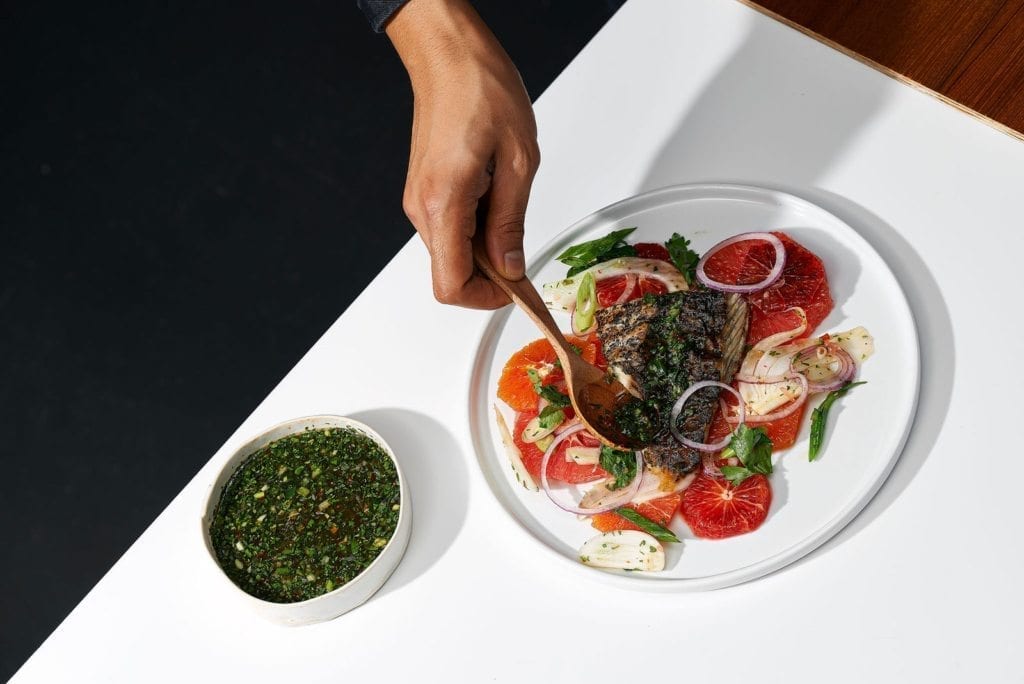Woldy Reyes on Healthy Eating: #EatColor

Chef Woldy Reyes of Woldy’s Kusina is known for his colorful and artful presentations and healthy, vegetable-driven menu. Both have made him a popular catering choice among the fashion set in New York City. Find out how he went from fashion to food, his take on healthy eating, and why cooking fish at home may just be quicker than ordering in.
Australis: Let’s start at the beginning: How did you get interested in making food?
Woldy Reyes: My mother and grandmother are the reason that I love food and making food. Growing up, my twin brother and I were dropped off at my grandmother’s house after school. She would always have a meal made for us of traditional Filipino food. I became interested in helping her make it and learned to cook from her.
As a result of my love for eating, I was overweight. For awhile, I had a love-hate relationship with food and I had to train my mind to look at food differently. Watching cooking shows, reading cookbooks and learning new habits helped me lose the weight. It helped to really know what foods I was making and eating.
In college, I majored in hotel and restaurant management. We learned the basics of cooking by a classically trained chef. I was always very comfortable in the kitchen. Before moving to New York, I worked in restaurants and interned at catering companies in California.
And how did you end up where you are today: From food to fashion and back to food?
I’ve always been a fan of fashion. I worked in the fashion industry for a few years when I moved to New York and then decided I just didn’t want to do it anymore.
I always knew I wanted to be in the food world somehow. While working in fashion, I realized that cooking food was more up my alley. It’s where I felt the happiest.
So, I left fashion, and while working part-time in retail, I started Woldy’s Kusina, my catering business. I began cooking privately for a fashion designer preparing weeknight meals and told all my friends about my food business. They started asking me to cater brunches and wedding showers, and it’s grown by word of mouth. It’s kind of taken a life of its own.
What’s your food philosophy?
I cook food that I would want to eat. The clients I work with want to eat the way I do: a focus on vegetables that are healthy but satisfying. I also believe in presenting food beautifully. You work so hard on it and it deserves a beautiful presentation, which in turn makes people appreciate it more. Working in fashion helped me train my eye and see things differently. This has translated into how I like to present my food.
Food should also be special. You eat with your eyes first. An artful presentation creates a conversation, you see the food and then you engage with it. My goal is to create an intimate experience.
When it comes to sourcing, I try to use sustainable, local, fresh, and organic whenever possible. When you follow the seasons you get the flavors at their peak. You won’t find me using tomatoes in January. I also source my chicken from a farm in Pennsylvania that humanely raises and harvests their animals. You can taste the difference. It’s better for the soul, too.
Your food is described as healthy. What does “healthy food” mean to you?
Healthy, to me, means: fresh with a focus on vegetables and fruits. Much of my menu is based on the seasons. I like to use fruits and vegetables, mostly in their natural forms, elevating the flavors with simple seasoning.
Healthy for me is also how you prepare the food. Most of my dishes are prepared by roasting, baking, and grilling rather than frying. It’s also about a balance: a salad, a vegetable, a grain, a protein, and one sweet.
How did you come across barramundi? How do you incorporate it into your menus?
I discovered barramundi at a demonstration by Australis at Brooklyn Foodworks. The fact that the fish is sustainable piqued my interest. (Sustainability is a trend that I hope it becomes more of a general practice.) When I tasted it, I was surprised by how good it was. I started introducing barramundi into my menu and change the preparation of the fish by season. For winter, I serve it grilled with a winter citrus and fennel salad and an Asian salsa verde.
What are your thoughts on the current state of food? What change would you like to see?
I think educating young kids on where their foods are coming from is really important. I live in Bedford-Stuyvesant where there is a drought of fruits and vegetables. When I go to the bodega I see kids buying candy because it’s the only thing there. There needs to be greater accessibility to more fruits and vegetables and to teach children about what they are and where they come from. It will give them a deeper understanding and help them make wiser decisions as they grow older.
Also, as a society, we’re becoming so dependent on instant gratification. Everything is at our fingertips. We’re becoming increasingly self-reliant on applications and technologies to order in. We eat out a lot. But everyone needs a basic understanding of cooking so that we can feed ourselves long term.
What’s the one food myth you’d like to debunk once and for all?
If you have a basic knowledge of food, it’s not hard to eat healthily. Although it does take some time to know what’s healthy, at the end of the day it’s time you need to take to stay alive. My rule of thumb is to #eatcolor. That’s when you know you’re eating the healthiest. Also, say no to brown foods!
What’s your favorite way to prepare seafood at home?
I love seafood. I’ve never met a sea creature that I didn’t like. For me, cooking fish is always the easiest, sauteing or roasting it. Cook it for 4 to 6 minutes on each side and it’s done. It’s quicker than ordering from Seamless.
I like to keep the seasoning simple: salt, pepper, olive oil and a squeeze of lemon juice. I pair it with a simple green salad for a quick and healthy meal. My days are hectic and busy—cooking fish is a simple way to get really good protein.
Check out Woldy’s recipe for Grilled Barramundi with Asian Salsa Verde and Citrus and Fennel Salad.
